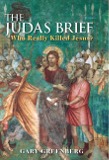In the Gospel of John (hereinafter, GJohn) the dialogues between Pilate and Jesus and between Pilate and the Jews are significantly longer than those found in the Gospel of Mark (hereinafter, GMark), the latter being almost universally accepted among NT historians as the earliest of the four canonical Gospels.
GJohn divides the dialogue between Pilate and Jesus into two segments and divides the dialogue between Pilate and the Jews into four segments, weaving these several segments together and interspersing other material, such as the mocking of Jesus by the Roman guards. As an experiment, I took the two segments with Jesus and linked them together as a single conversation and took the four Jewish segments and linked them together as a single conversation. I then separately examined the two conversations for logical narrative flow.
A critical reading of these two separate conversations suggested, at least to this analyst, that there was something odd about both dialogues. There appears to be three major problems. First, in terms of narrative flow some of the questions and answers within each of the two separate conversations seem to be out of logical chronological order. Second, some of the answers in each conversation seem as if they belonged to different questions within the same conversation, as if someone shuffled the original answers around and reassigned them to different questions. Third, while the questions that Pilate asks Jesus in GMark also appear in approximately the same form in GJohn, in the latter they get different response from Jesus. Similarly Jesus' responses to Pilate in GMark also appear in GJohn but as responses to different questions than those asked in GMark.
In this essay I will argue that 1) the author of GJohn had a written source for these two extended conversations; 2) this earlier written source originated as an attempt to address perceived shortcomings in a still earlier version of the Passion Narrative that was similar to what appears in GMark; and 3) the author of GJohn, in order to address additional concerns, further reworked this written revision by rearranging the order of the questions and answers.
In Part 2: Pilate Talks to Jesus: GMark vs. GJohn
Tuesday, January 9, 2007
Pilate's Extended Dialogues in the Gospel of John: Did the evangelist alter a lost written source? Part 1: Introduction
Labels:
GJohn,
GMark,
Gospel of John,
Jesus,
Jesus Quest,
Jews,
Pilate,
source criticism,
text criticism
Subscribe to:
Post Comments (Atom)



2 comments:
Gary: Sounds interesting. Why don't you link directly to the texts that you're analyzing?
HEROD & Pilate Didn’t seek Jesus death
By Andre Austin
“It is a cogent and potent fact, calculated to render the story of the murder of the Hebrew children by Herod wholly incredible, that not one writer of that age, or that nation, or any other nation, makes any mention of the circumstance.
Even the rabbinical writers who detail his wicked life so minutely, and who bring to his charge so many flagitious acts, fail to record any notice of this horrible and atrocious deed, which must have been published far and wide, and known to all the writers of that age and country, had it occurred.
And still more logically ruinous to the credit of the story is the omission of Josephus to throw out one hint that such a wholesale slaughter ever took place in Judea. And yet he not only lived in that country, but was related to Herod’s wife, and regarded him as his most implacable enemy, and professes to write out the whole history of his wicked life in the most minute detail, devoting thirty-seven chapters of his large work to this subject, and apparently enumerates every evil act of his life. And yet Josephus says not a word about his inhuman and infamous butchery of the babes which Matthew charges him with.-(Kersey Graves The Worlds sixteen crucified saviors). Josephus does report that Herod was very fond of the Essene and this makes no logic as to why he would seek the death of a Jesus who was associated with the Essenes.
Now we turn to Pontius Pilatus, the Roman Procurator in this period of time is supposed to have washed his hands and passed on responsibility for the death of Jesus to the blood seeking crowd. The washing of hands to indicate innocence was the custom of the Essenes community rituals. The Bible says that it was the Roman custom at the time of the Passover festival to offer a prisoner for release, but this is simply not true. There was no such custom and the scene is invention. Pilate, a Roman wouldn’t be involved in Essense or Jewish rituals.
I would offer evidence that the washing of hands was ultimately an Egyptian ritual. Look at Horus who said in the Judgement Hall court : “I’am clean of mouth and clean of hands” Egyptians Ideas of the Afterlife By E.A. Wallis Budge.p151. This proves the Essenes custom of washing hands to prove innocence is of Egyptian origin; which is a serious and most important development. Horus is in a Judgement hall where guilt or innocence was determined. Additional indirect evidence is provided later. Even now to this day the “Clean hands” doctrine of Egyptian law has been handed down to us. Just Read any law dictionary and it will say: “Under this doctrine, equity will not grant relief to a party” to those without clean hands see Blacks Law Dictionary. Pilate “Took water and washed his hands in the sight of the crowd, saying ‘I am innocent of this man’s [Jesus] blood. Look to it yourselves”-Matthew 27:24.
I can further produce evidence The washing of hands is Essene/Egyptian tradition. Go to John 13:10 where Jesus is washing the feet of his disciples.” A person who has had a bath needs only to wash his feet; his whole body is clean. And you (Peter) are clean, though not every one of you. For he knew who (Judas) was going to betray him, and that was why he said not everyone was clean”. The context of guilt vs. innocence was linked with washing/clean. This also links NT writings with Essene and Egyptian writings. Pilate , a Roman wouldn’t of been a participant in this ritual because they despised the Egyptians at this time..
If Pilate, whether mistakenly or not, had truly considered Jesus guilty of spear-heading a seditious movement, more than just Jesus would have died. That fact that Jesus alone was killed suggests that Pilate knew perfectly well that he posed no political threat. But then that raises the more fundamental question: If Pilate knew Jesus were politically innocent, why crucifixion at all? If the prefect — or, as the Gospels depict, the priests — simply wanted Jesus dead, no public execution was necessary. They could have killed him by easier means. And the same Gospels’ insistence on Jesus’ very popularity that Passover (the priests resolve to have him killed, says Mark, "but not during the feast, lest there be a tumult of the people" 14:2) makes the choice of a public execution that much more mysterious.
This is circumstantial evidence that if there was a Jesus he died not in the time of Pilate but in a different time under a different name.
Notes:
In order to get to heaven one has to be first found in a “Book of deeds” and you must wash yourself up in a lake with scared water. “No man could hope to see god unless he could say ‘I have purified my breast and body with clean water, I have purified my hinder parts...and my inward parts have been dipped in the pool of Maati/Truth; no one member of mine lacks maat” This sounds very much like “except a man be born of water and of the spirit, he cannot enter into the kingdom of god” John 3:5
Post a Comment